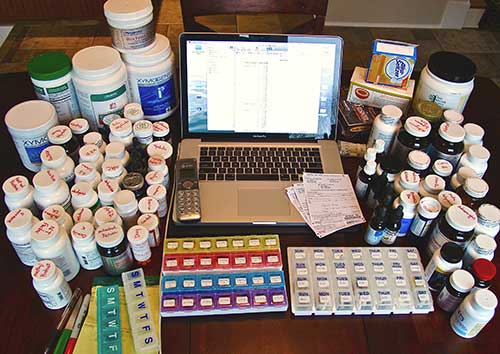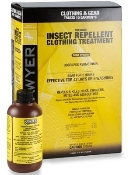
You don’t “get” Lyme until you get Lyme.
On April 24, 2010, my life changed abruptly and without notice. Until then, I had routinely been swimming 100 lengths in a nearby pool several days a week with aerobic and strength training workouts at the fitness center on non-swim days. In hopes of finally dropping some excess weight, I pushed myself to the max during these workouts. One morning, to my surprise, I had to call it quits after 50 lengths in the pool. From the start, every lap felt like I was swimming through molasses. Thinking my extreme fatigue was simply a matter of overtraining, I rested for several days to recover. When I returned to the pool with great expectations, I had trouble getting going and barely eked out twenty lengths with a supreme effort. I knew then that something was terribly wrong. This was unlike any sensation I had ever experienced!
With each passing day, new symptoms emerged, including drenching day and night sweats, panic attacks, flu-like symptoms, sore throat, splitting headache, bronchitis, muscle and joint pain, and relentless insomnia. My mysterious illness progressed over the next eight months to include over thirty-five symptoms. It often took at least 30 minutes to harness enough focus and willpower to manage a standing position.
Once I was up, every task seemed to get done on pure adrenaline that left me completely spent. I was struggling to remain cognitively and physically functional and work was totally out of the question. Every day it seemed I was forced to further scale back expectations to an appropriate balance of activity. I remember just removing the lights from the Christmas tree or taking a shower was more than I could handle. My days became more isolated and less productive as I struggled just to get necessary tasks done. I felt so diminished as a person and was no longer functional.
The Fight for a Diagnosis
Periodic visits with my trusted primary care physician resulted in no diagnosis beyond my bronchitis with a prescription to go home and get more rest. At each appointment, I came back “rested” with new symptoms to report. Each time the prescription was for continued rest. My lab tests indicated nothing abnormal and a Lyme Elisa test came back negative, so that was ruled out.
Perhaps I should see a specialist, I suggested. My busy doctor put the burden on me to go home and research the appropriate specialist to see, and then he would make the appointment. So, I saw an infectious disease specialist next, who diagnosed me with post-nasal drip. Really? At my follow-up appointment after using the prescribed treatment of an inhaler and drops, I reported that the last of the bronchitis had cleared but all the other symptoms were still plaguing me. She pleasantly stated that things are moving in the right direction and that I should be feeling much better soon. At that moment, it hit me; my PCP and infectious disease doctor were not taking my reported misery seriously and were thinking this was all in my head.
“Resting” again back home, I went online and researched potential sources for my growing dysfunction. My temporary self-diagnosis was fibromyalgia and chronic fatigue immune deficiency syndrome based on my worst symptoms. Eight months into this medical journey, I made a two-hour consult at a clinic in Norwalk specializing in these two diseases. Sixteen tubes of blood and four weeks later, my follow-up telephone consult revealed many abnormal lab results. I was then told that I was one of the sickest patients they had seen in some time and the clinical diagnosis was Lyme disease and three other tick-borne illnesses.
Prior to this, I was not really aware of Lyme disease and had no known tick bite or rash. Once I had the diagnosis and after exploring many online resources, including Lyme support chat rooms and Lyme advocacy and medical organizations, I knew the diagnosis hit the nail on the head. I learned that my pathway back to a state of wellness was most likely going to take months, perhaps years.
Since then, I’ve had a total of four integrative functional doctors who independently confirmed the diagnosis. These dedicated doctors all employ multiple modalities in their treatment philosophies that range from traditional allopathic* medicine to herbals and other alternative healing methods. My full-time job as a proactive patient has been to learn all I could about tick-borne illnesses and to be as close to 100% compliant with my ever-changing complex treatment protocols. When I feel up to it, I try to raise awareness in the community about the increasing dangers of tick-borne illness.
Lyme Disease: The Great Imitator
Lyme disease is often referred to as the great imitator because it involves multiple systems and manifests differently from patient to patient. Misdiagnosis as another autoimmune or auto suppression disease is common. Some unfortunate patients visit dozens of specialists over years or decades before being correctly diagnosed and treated for Lyme disease. Only then do many of them finally get appropriate treatment and begin to feel significantly better.
The Importance of Finding Experienced Practitioners
Under-treating or misdiagnosing Lyme disease is all too common in our nation’s healthcare facilities because the majority of doctors lack adequate updated education in tick-borne illnesses. Because of this, doctors often resort to using a flawed lab test for Lyme disease as their primary means for diagnosis. Available testing is unreliable and results far too often show false negatives. Many doctors still follow outdated diagnosis and treatment guidelines inspired by the outdated IDSA Lyme guidelines which have now been delisted by the National Guidelines Clearinghouse (NGC). Everyone should know that there is more than one set of guidelines to choose from and it is their right to have a say in how their treatment is developed. Finding a doctor experienced in Lyme disease is an important part of getting an appropriate diagnosis and treatment plan in place before further damage sets in.
The International Lyme and Associated Diseases Society (ILADS) has the most up to date resources to educate the best Lyme-dedicated doctors. Their website at www.ilads.org offers considerable information on tick-borne illnesses. Their doctor referral service has helped many patients find a knowledgeable doctor in their region. Two other great online sources for useful information can be found at www.lymedisease.org and www.mainelymedisease.org for starters.
Incomplete treatment with antibiotics or antimicrobials may only partially knock down the pathogen load which can then disseminate throughout the body after short-term treatment ends. When the Borrelia spirochetes become entrenched throughout the body into non-vascularized tissue, it is more difficult for your body’s own immune defenses or introduced antibiotics to access the persistent invaders. The ability of the bacteria to morph into various forms makes treatment more challenging. Multiple antibiotics and antimalarials are needed to target the different forms of the spirochetes and other coinfection bacteria. Untreated or persistent tick-borne pathogens can emerge and multiply weeks, months or years later from a state of dormancy and cause more and more symptoms with greater severity. At that point, Lyme disease is frequently not suspected because the tick bite occurred so long ago and is often forgotten. Now it may be impossible to eradicate.
What makes continual misdiagnosis even more tragic is that the odds of curing Lyme disease improve with early diagnosis and treatment with antibiotics. I even encourage people to request a course of antibiotics whenever they find a tick has attached. You must be vigilant to stop the progression (or start) of the disease before it takes root.
Remission! Then Reemergence
Four and a half years of travel to distant Lyme doctors, who prescribed very complex treatment protocols, rewarded me with total remission. Slowly but surely, after countless ups and downs, I was whole again with no lingering symptoms except for the physical de-conditioning that resulted from years of “rest.” I was given a second chance at life!
However, after more than a year, my remission ended thirteen months ago with the reemergence of some all too familiar symptoms. I’ve been in progressively more robust treatment to put the evil genie back in the bottle. I’ve learned that, for many disseminated chronic Lyme patients, relapses are common and a cure is unlikely until much-needed future research is conducted. So, for now, remission is the goal.
The Best Treatment is Prevention
The best treatment is to prevent Lyme disease in the first place by taking measures to reduce the risk of tick bites. My strategy relies heavily on permethrin. Permethrin is an insecticide that is highly effective in killing or repelling ticks. It is made of synthetic chemicals that act like natural extracts from the chrysanthemum flower. Although it is a chemical, according to the Tick Encounter Resource Center at the University of RI, permethrin is 2,250 times more toxic to ticks than it is to humans. The EPA considers permethrin to be 27 times below toxicity levels for humans when used on clothing. After my years of prolonged suffering, I’ll gladly take the low-level permethrin toxicity risk over the misery of chronic Lyme any day.
- I soak three sets of light-colored outdoor clothing in permethrin at the onset of spring (light colors make it easier to see ticks). I buy it in a box of ten treatments and soak the clothing for three hours and line dry. Once the permethrin is absorbed into the fabric and has been dried, it is still effective after six to ten cycles in the washing machine.
- I make sure to tuck my pant legs into my socks and my shirt into the waist of my pants. I periodically spray my shoes and socks with permethrin to complete the barrier.
Most ticks make contact at ground or ankle level and then start crawling up. Before a tick can reach my neck, they will be dead or repelled. I feel it’s close to foolproof. I’ll still do a thorough tick check after I return indoors to be sure there are no unwanted hitchhikers. I have not found any ticks on me since I began using this strategy.
Hitting Them Where They Live
The ideal tick habitat is one that is moist and warm. Leaf litter and tall grasses are prime tick territory, as are locations where you find large densities of mice, songbirds, and deer. Consequently, you’ll find greater numbers of ticks near stone walls, woodpiles, and bird feeders as well as in open fields. I even set out permethrin soaked cotton balls stuffed in paper towel cardboard tubes in various outbuildings for my mouse population to take home and line their nests. The mice pick up lots of larval and nymphal sized ticks, return to the nest and kill them while sleeping in their cozy cotton-lined beds.
Since we’re on the topic of “where they live,” it’s very important to remember that ticks aren’t just found in remote areas. As a matter of fact, 80% of bites are in your backyard and they’re in cities like Portland, too. For maps and charts on Maine Lyme trends, visit the Maine Tracking Network Data Portal and click on Lyme Disease in the portal menu.
Awareness and Education are the Keys to Prevention
Like most Lyme patients, I had very little prior knowledge of tick-borne illnesses before that challenging day of twenty lengths in the pool. Becoming infected with Lyme disease (LD) was not really on my radar and I believed it is something that happens to a small number of unfortunate individuals. I never saw the tick that changed my life. I never developed a telltale rash. In fact, at least half of Lyme patients never see a tick or develop a rash, so it takes longer for them and their PCPs to consider Lyme disease as the root cause of their growing dysfunction and loss of energy.
The Center for Disease Control (CDC) and the Infectious Disease Society of America (IDSA) still believe, as I did, that Lyme disease is difficult to get and easy to cure with a short course of antibiotics. The truth is often just the opposite! I’ve learned that Lyme is easy to get and frequently difficult to cure, especially if it is not diagnosed and treated soon after the infecting tick bite. For years, the CDC reported new confirmed cases of LD at roughly 30,000/year. Several years ago, the CDC revised the number to roughly 300,000 new suspected cases of LD nationwide. Many Lyme specialists believe those numbers are still too conservative.
Tick-borne illnesses are on the rise and have now become a worldwide epidemic with no signs of decline. It is estimated that Lyme disease is roughly six times more prevalent than HIV/AIDS in the USA and yet it only receives 1% of the federal funding that AIDS research is allocated. What’s wrong with this picture? In the last several years there is considerably more media coverage of Lyme disease and some progress in helpful legislation is being enacted because the Lyme community is tragically growing at 300,000 people per year and consequently awareness is increasing.
Lessons Learned the Hard Way
I’ve learned some important lessons from living with the daily consequences of various tick-borne illnesses. Over the past seven years, I have conducted a determined search for answers and a cure. Through extensive reading, attending conferences and talking to Lyme patients and doctors, I developed a strategy to help me find my pathway back to wellness. One of the superstar Lyme doctors, Dr. Richard Horowitz, now refers to Lyme disease as Multiple Systemic Infectious Diseases Syndrome or Lyme-MSIDS. This better describes the illness, but I’ll also continue to refer to it as Lyme and its associated co-infections for now.
I’ve learned that there is no silver bullet for curing Lyme disease and that every Lyme patient is different with unique genetic weaknesses and different array of symptoms. Carrying heavy pathogen metal loads in our bodies challenge our immune function and result in considerable damage to our bodies over time. Our modern lifestyle in a toxin-laden environment is a major contributing factor to the rampant growth of Lyme disease cases and other chronic illnesses.
One of the main lessons I’ve learned from my Lyme experience is that knowledge is key. Investigating the latest research about this complex medical issue will help you make better decisions on your journey to recovery. It pays big dividends to be a proactive patient, build a team comprised of Lyme-literate caregivers and establish a support network as you commit to being nearly 100% compliant with the prescribed treatment protocol. Because of no prior experience with tick-borne illnesses, many patients just go along for the ride and blindly follow their doctor’s orders. There is a risk that the doctor may misdiagnose or under-treat the patient because of inadequate experience with tick-born illnesses.
I’ve also learned that there is nothing easy about Lyme. It is a complex, controversial, political, and potentially life-changing ordeal. I’ve learned that chronic Lyme patients must not only attempt to kill off the various tick-borne infections while they feel miserable, but they must also normalize dysfunction occurring in the body’s systems with the extensive use of medical supplements, medications and anti-inflammatory dietary changes. We must ensure quality restorative sleep, maximize cellular nutrition levels, increase immune function, support adrenal, endocrine, mitochondria, and liver function to create an internal environment conducive to healing. The pathways of detoxification must be opened up and maximized to remove the increased toxic debris released into our bodies from the die-off of pathogens during treatment. At one point I was on about 100 medications and supplements and was self-administering injection treatments. There is truly nothing easy about Lyme.

At the most chronic point of my disease, I was on about 100 medications and supplements and was self-administering injection treatments.
Through Adversity, Always Search for the Silver Lining
Despite the obvious downside of chronic MSIDS, there are some unexpected silver linings. Invaluable perspective is gained from enduring the storm and through sustained adversity. If you come through to the other side, there is a greater capacity for acceptance, tolerance, empathy, compassion, appreciation and so much more. Instead of seeing the glass as half full, I now see it as always full of life-giving air, even when it appears to have only a few sips remaining. Protecting the sense of humor center in my brain, wherever that is, from those evil spirochetes helped me crack a joke even during the darkest moments of Lyme disease.
For a list of Tom’s top Lyme disease resources, visit https://www.coastalpharmacyandwellness.com/lyme-disease-resources.
*Allopathic medicine is an expression commonly used by homeopaths and proponents of other forms of alternative medicine to refer to mainstream medical use of pharmacologically active agents or physical interventions to treat or suppress symptoms or pathophysiologic processes of diseases or conditions.


